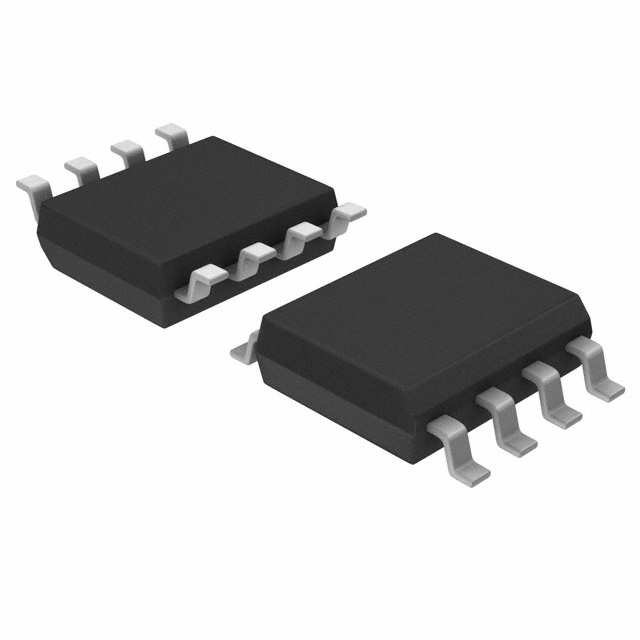Consulte las especificaciones para obtener detalles del producto.

LM393DRE4
Product Overview
Category: Integrated Circuit (IC)
Use: LM393DRE4 is a dual differential comparator designed for use in automotive and industrial applications. It is commonly used to compare two voltage inputs and provide a digital output based on the comparison result.
Characteristics: - Dual differential comparator - Wide supply voltage range: 2V to 36V - Low input offset voltage: ±1mV - Low input bias current: ±25nA - Low propagation delay: 1.3μs - Operating temperature range: -40°C to +125°C
Package: SOIC-8 (Small Outline Integrated Circuit), surface mount package with 8 pins.
Essence: The LM393DRE4 is an essential component in various electronic circuits where voltage comparison is required. It provides a reliable and accurate digital output based on the comparison of two input voltages.
Packaging/Quantity: The LM393DRE4 is typically available in reels or tubes, with a quantity of 2500 units per reel or 98 units per tube.
Specifications
- Supply Voltage Range: 2V to 36V
- Input Offset Voltage: ±1mV
- Input Bias Current: ±25nA
- Propagation Delay: 1.3μs
- Output Current: 6mA
- Operating Temperature Range: -40°C to +125°C
Pin Configuration
The LM393DRE4 has 8 pins arranged as follows:
___________
VCC | 1 8 | GND
IN- | 2 7 | OUT
IN+ | 3 6 | NC
GND | 4 5 | NC
‾‾‾‾‾‾‾‾‾‾‾
Functional Features
- Dual differential inputs for voltage comparison
- Open-drain output configuration
- Wide supply voltage range allows for versatile applications
- Low input offset voltage and bias current ensure accurate comparisons
- Fast propagation delay enables real-time response
Advantages and Disadvantages
Advantages: - Wide supply voltage range makes it suitable for various applications - Low input offset voltage and bias current ensure high accuracy - Fast propagation delay allows for real-time response - Compact SOIC-8 package saves board space
Disadvantages: - Limited number of pins may restrict complex circuit designs - Open-drain output configuration requires external pull-up resistor for certain applications
Working Principles
The LM393DRE4 operates by comparing the voltages applied to its two input pins, IN+ and IN-. When the voltage at IN+ is higher than the voltage at IN-, the output pin (OUT) is pulled low. Conversely, when the voltage at IN- is higher, the output pin remains high impedance.
Detailed Application Field Plans
The LM393DRE4 finds extensive use in automotive and industrial applications, including but not limited to: 1. Battery voltage monitoring 2. Overvoltage/undervoltage protection circuits 3. Motor control systems 4. Level detection circuits 5. Signal conditioning circuits 6. Sensor interfaces 7. Power supply monitoring
Detailed and Complete Alternative Models
- LM2903: Single differential comparator with similar specifications and pin configuration.
- LM339: Quad differential comparator with similar specifications and pin configuration.
- LM311: High-speed differential comparator with additional features such as adjustable hysteresis.
These alternative models provide similar functionality to the LM393DRE4 and can be used as substitutes depending on specific requirements.
In conclusion, the LM393DRE4 is a dual differential comparator widely used in automotive and industrial applications. Its compact size, wide supply voltage range, and accurate voltage comparison make it an essential component in various electronic circuits.
Enumere 10 preguntas y respuestas comunes relacionadas con la aplicación de LM393DRE4 en soluciones técnicas
Sure! Here are 10 common questions and answers related to the application of LM393DRE4 in technical solutions:
Q: What is LM393DRE4? A: LM393DRE4 is a dual differential comparator IC (integrated circuit) commonly used in electronic circuits for comparing voltages.
Q: What are the key features of LM393DRE4? A: Some key features of LM393DRE4 include low power consumption, wide supply voltage range, open-collector outputs, and built-in hysteresis.
Q: How does LM393DRE4 work? A: LM393DRE4 compares two input voltages and provides a digital output based on the comparison result. If the non-inverting input voltage is higher than the inverting input voltage, the output goes high; otherwise, it goes low.
Q: What are the typical applications of LM393DRE4? A: LM393DRE4 is commonly used in applications such as level detection, line following robots, motor control, battery chargers, and proximity sensors.
Q: What is the operating voltage range of LM393DRE4? A: The operating voltage range of LM393DRE4 is typically between 2V and 36V.
Q: Can LM393DRE4 handle analog signals? A: No, LM393DRE4 is a digital comparator and can only handle digital signals. It compares the voltage levels of two inputs and provides a digital output accordingly.
Q: Does LM393DRE4 require external components for operation? A: Yes, LM393DRE4 requires external resistors and capacitors for proper biasing and stability in most applications.
Q: What is the output configuration of LM393DRE4? A: LM393DRE4 has open-collector outputs, which means it can sink current but cannot source current. It requires a pull-up resistor to provide a logic high output.
Q: Can LM393DRE4 operate in harsh environments? A: LM393DRE4 has a wide temperature range and is designed to operate in industrial environments, making it suitable for use in harsh conditions.
Q: Is LM393DRE4 available in different package options? A: Yes, LM393DRE4 is available in various package options, including SOIC (Small Outline Integrated Circuit) and PDIP (Plastic Dual In-line Package).
Please note that these answers are general and may vary depending on specific datasheet specifications and application requirements.

